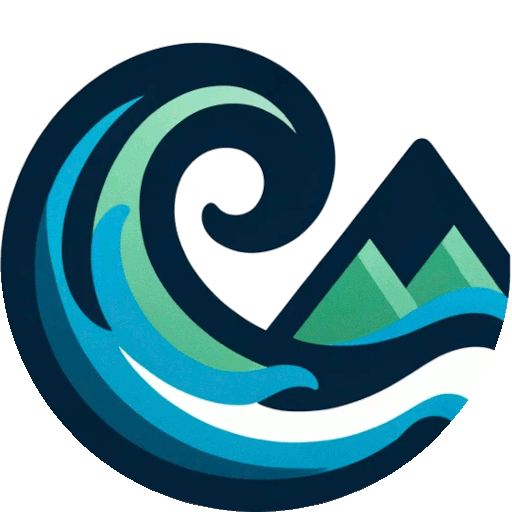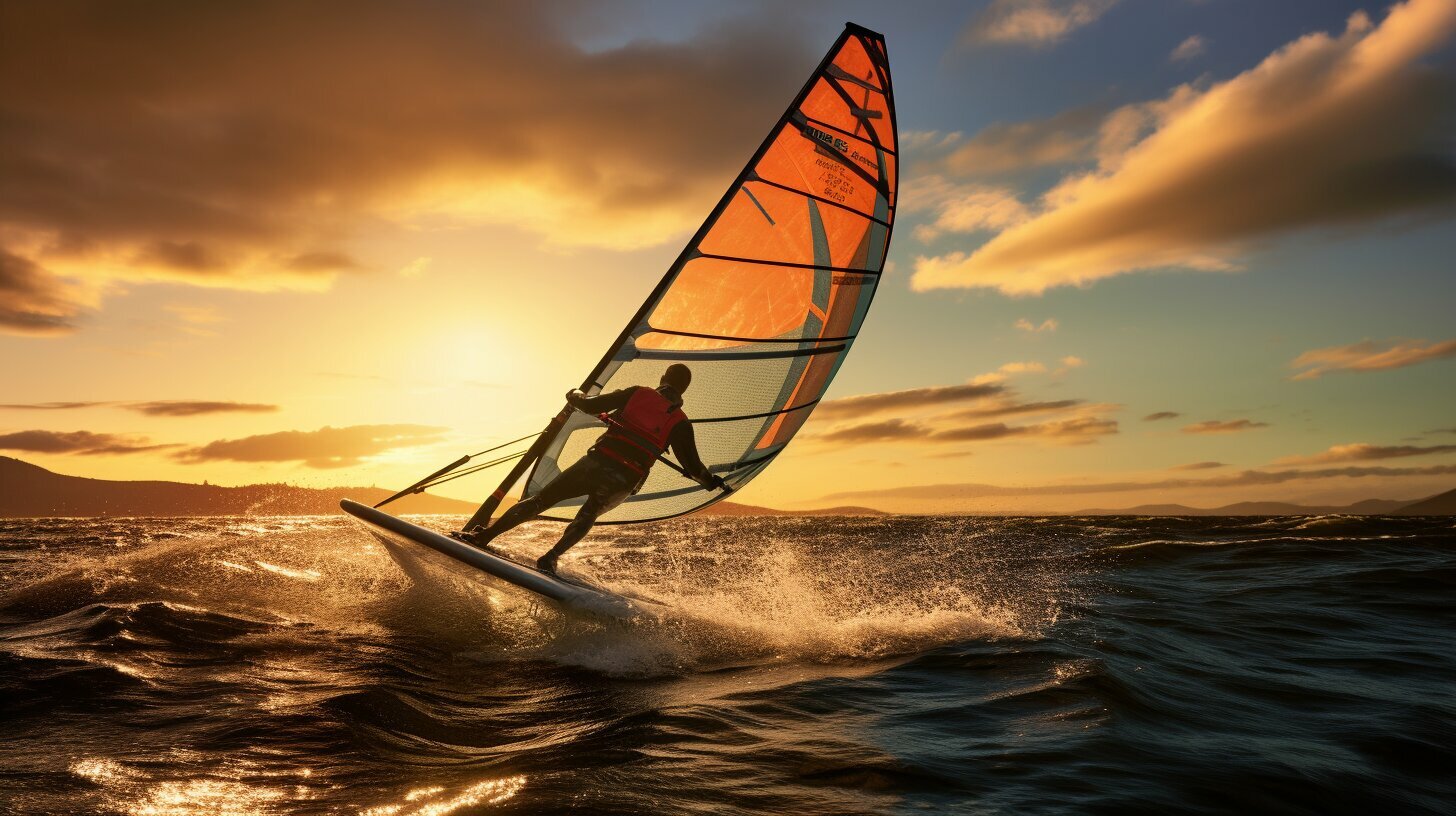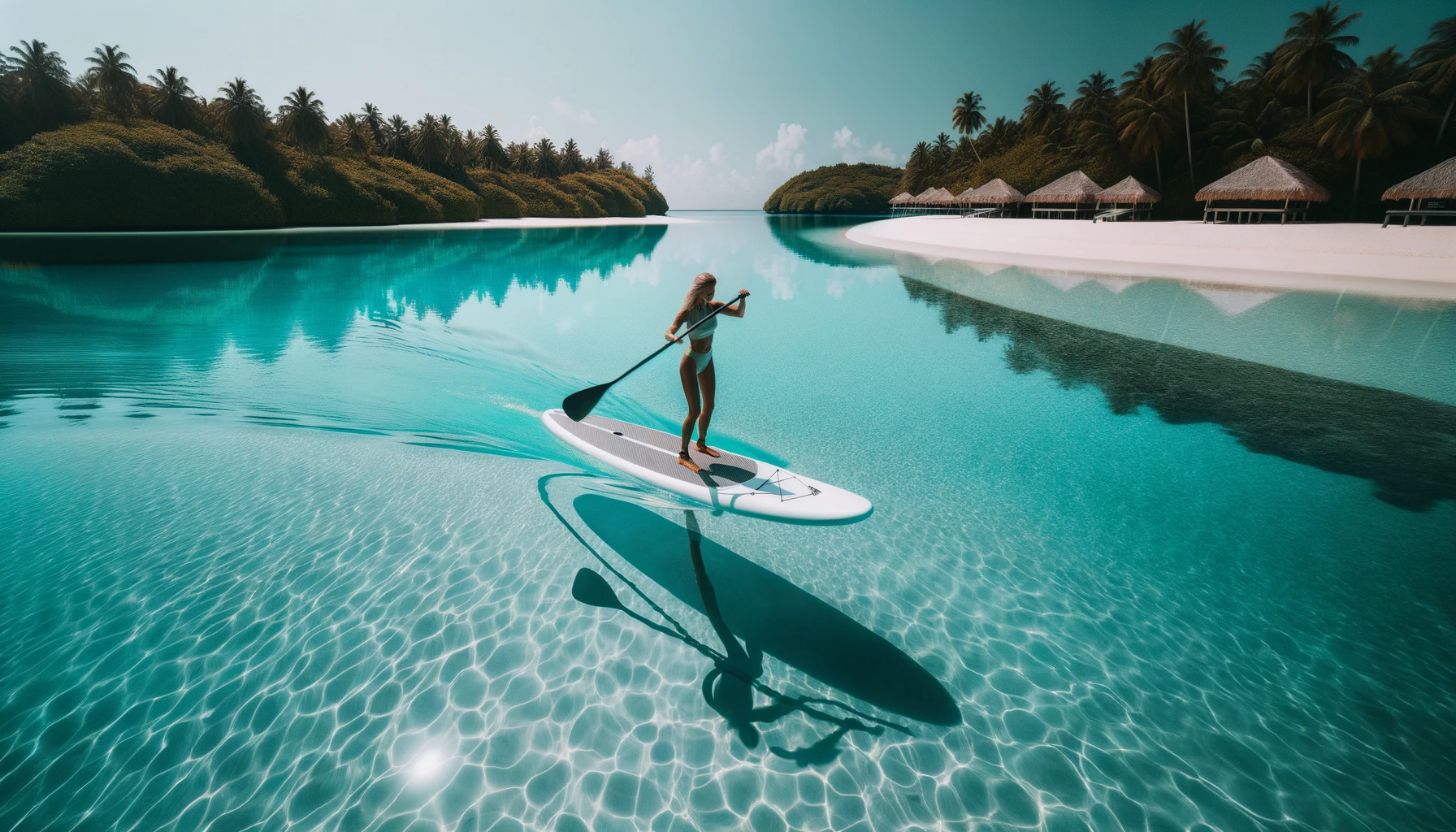If you’re looking for an exciting and adventurous water sport, windsurfing is a great option for beginners. Combining the thrill of sailing with the challenge of balancing on a board, windsurfing offers a unique and exhilarating experience on the water. However, as with any sport, learning the basics is crucial to ensure your safety and enjoyment. In this beginner’s guide to windsurfing, we will cover everything you need to know to get started, including equipment, technique, safety, and more.
Key Takeaways
- Windsurfing is an exciting and challenging water sport for beginners.
- Learning the basics is crucial to ensure safety and enjoyment on the water.
- This beginner’s guide will cover everything you need to know to get started with windsurfing, from equipment to technique to safety.
- By following the tips and techniques outlined in this guide, you can master the waves and achieve success as a beginner windsurfer.
- Remember to always prioritize safety and practice regularly to enhance your skills and improve your windsurfing experience.
Getting Started with Windsurfing
Before you can hit the waves, it’s important to understand the basics of windsurfing. Here’s what you need to know:
Equipment
To get started with windsurfing, you’ll need a board and a sail. There are different types of boards and sails available, but as a beginner, you’ll likely want to start with a wider board and smaller sail. This will provide more stability and control, making it easier to learn the basics.
Disclosure: When you buy through links on our site, we may earn an affiliate commission.
You’ll also need a wetsuit, harness, and life jacket for safety and comfort while on the water.
When purchasing your gear, it’s important to ensure that it’s all compatible with each other. You can consult with a sales representative or instructor to ensure that your gear matches.
Setting Up Your Gear
First, find a suitable location with calm and shallow waters and consistent wind. Once you’ve found your spot, lay out your board on the sand or grass, and assemble the mast, sail, and boom. Make sure to secure everything tightly.
Before heading out onto the water, it’s important to test your mast foot and universal joint to ensure they’re secure. You should also check your sail’s downhaul and outhaul to make sure they’re properly adjusted.
When you’re ready to launch, carry your board to the water and position yourself so that the sail is downwind and the board is perpendicular to the waves. Hold the mast with one hand and the boom with the other, and step onto the board with one foot at a time.
Once you’re on the board, get into the proper stance, which we’ll discuss in the next section.
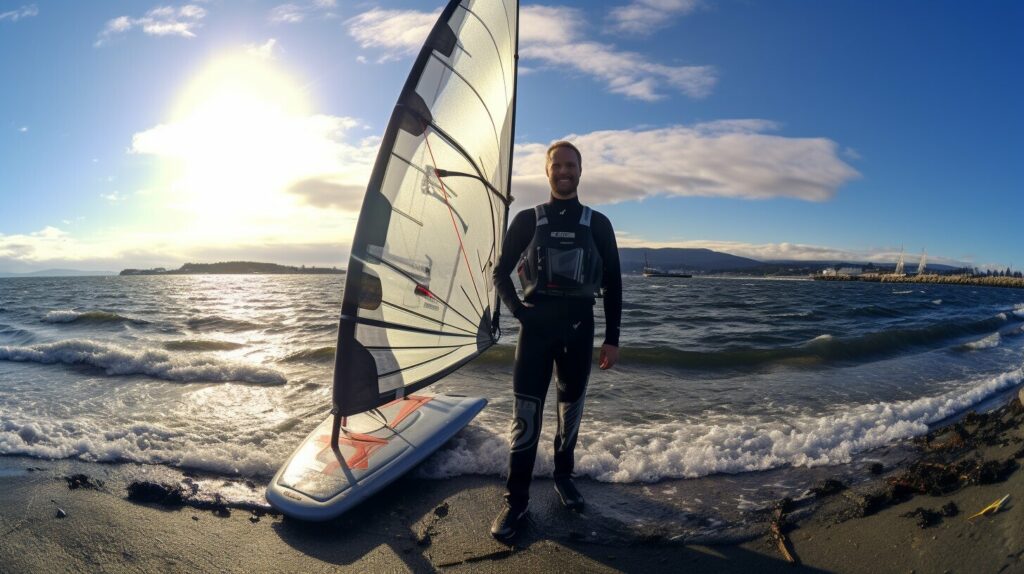
Proper stance and balance are essential for staying upright and in control while windsurfing. Here are some tips:
- Stand on the board with your feet shoulder-width apart and your knees slightly bent.
- Hold the boom with both hands, keeping your arms straight and relaxed.
- Look towards the sail, and lean back slightly, keeping your weight centered over the board.
- Keep your head and shoulders upright and your hips facing forward.
- Shift your weight as needed to maintain balance and control.
Practice your stance and balance before trying any techniques or maneuvers. You want to feel comfortable and stable on the board before progressing further.
Mastering Windsurfing Stance and Balance
Achieving the right stance and balance is crucial for a successful windsurfing experience. It’s important to keep your body centered on the board and your weight distributed evenly. This will help you maintain stability and control, especially in rough water conditions or strong winds.
To get into the proper stance, stand on the board with your feet shoulder-width apart and facing forward. Your front foot should be positioned just behind the mast base, while your back foot should be slightly further back, facing sideways. Keep your knees slightly bent and your weight balanced between your feet.
Once you’ve found your balance, you can start to move the sail and steer the board. Keep your arms extended and hold the boom with a firm grip. When turning, shift your weight to your back foot and lean the sail away from the direction of the turn. For upwind sailing, angle the sail towards the wind and lean forward to increase speed.
It’s important to practice your stance and balance regularly, both on land and in the water. Try a few exercises such as balancing on one foot, shifting your weight from side to side, or practicing jibes and tacks. With regular practice, you’ll be able to maintain your balance and control, even in challenging wind and water conditions.

Remember, windsurfing is a sport that requires patience, perseverance, and practice. Don’t get discouraged if you don’t get it right the first time. Keep practicing and you’ll soon master the basics of windsurfing and be ready to progress to more advanced techniques. In the next section, we’ll cover some essential windsurfing maneuvers for beginners.
Essential Windsurfing Techniques for Beginners
Now that you have a solid foundation in the basics of windsurfing, it’s time to learn some essential techniques to help you navigate the water with ease. Here are some windsurfing techniques every beginner should know:
- Steering: To steer your board, use your back hand to tilt the sail toward the direction you want to go. Your front hand should remain at shoulder height to maintain balance.
- Tacking: To change direction with the wind at your back, perform a tack. Turn the board so the nose is pointing into the wind and use your back hand to switch sides of the sail.
- Jibing: To change direction with the wind at your front, perform a jibe. Turn the board downwind and use your back hand to move the sail to the other side of the board.
- Upwind sailing: To make progress against the wind, sail diagonally upwind by adjusting the angle of the sail and using your weight and balance to maintain momentum.
Remember, mastering these windsurfing techniques takes time and practice. Don’t get discouraged if you don’t get it right away. Keep practicing and experimenting with different techniques until you find what works best for you.
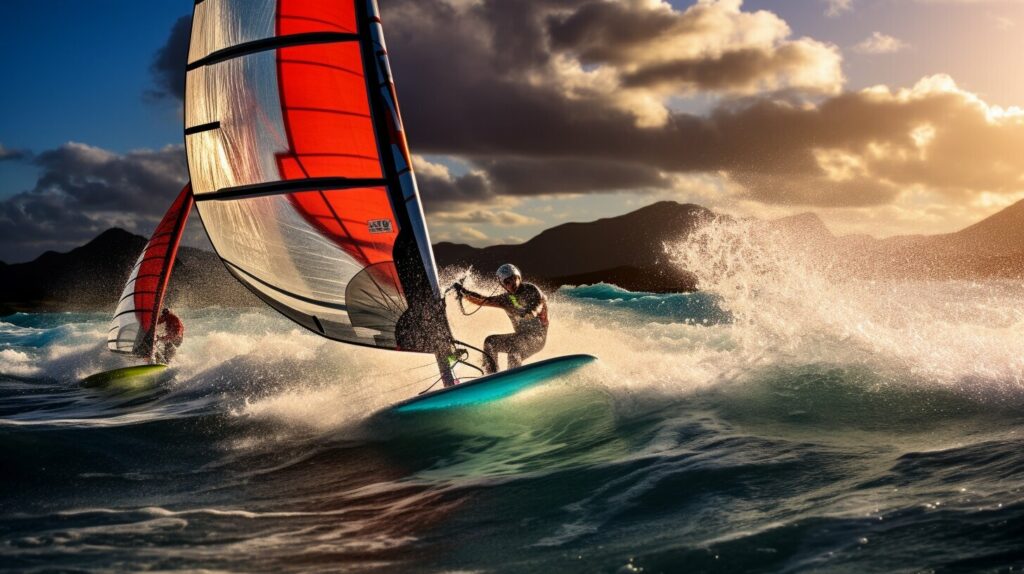
As you progress in your windsurfing skills, consider taking lessons with a qualified instructor to help you improve your technique and learn more advanced maneuvers. Keep in mind that safety should always be your top priority while windsurfing.
Try it out!
Head out to a calm body of water and practice some of these essential windsurfing techniques. Remember to stay safe and have fun!
Understanding Wind and Weather Conditions
Windsurfing is a sport that is heavily influenced by wind and weather conditions. As a beginner, it is important to have a basic understanding of these factors to ensure a safe and enjoyable experience on the water.
Wind Direction: The direction from which the wind is blowing is crucial in windsurfing. It is important to know which way the wind is coming from and how it will affect your board and sail.
Wind Strength: Wind strength is another important factor to consider. A beginner should aim for wind speeds between 10-15 knots, as higher wind speeds can be more challenging to handle.
Weather Forecasts: Checking weather forecasts before heading out to the water is essential to ensure safety. Be prepared for any potential changes in weather, such as sudden gusts or storms.
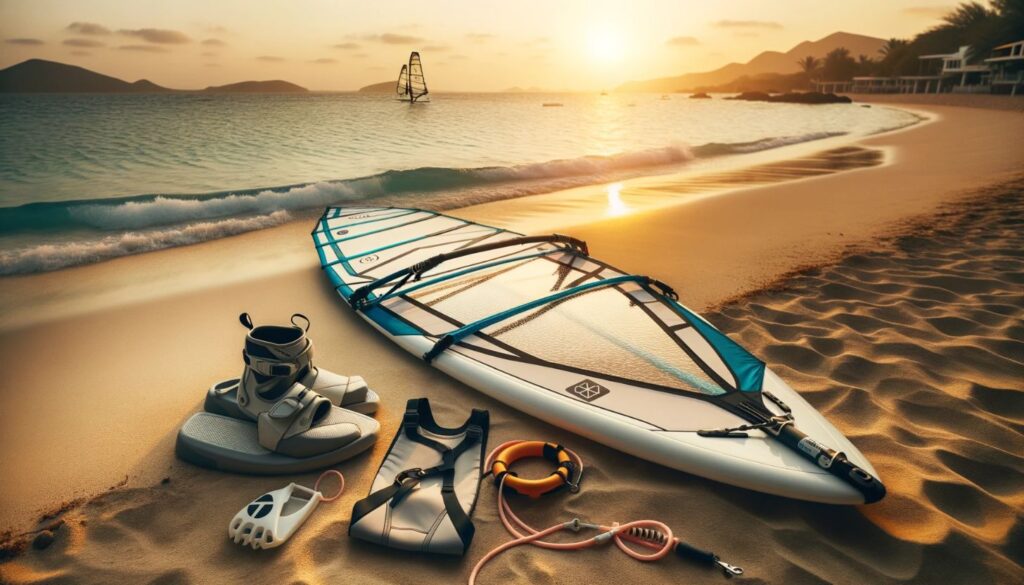
Remember to always check the weather conditions and wind forecast before you head out. Familiarize yourself with the different types of wind and know how to read weather forecasts. By understanding wind and weather conditions, you can make informed decisions and enjoy windsurfing to the fullest.
Safety Tips for Windsurfing Beginners
While windsurfing can be an exhilarating experience, it’s important to prioritize safety to avoid any accidents or injuries. Here are some essential windsurfing safety tips to keep in mind:
- Always wear appropriate safety gear: This includes a wetsuit, life jacket, and helmet. In colder waters, consider wearing a neoprene hood and gloves for added protection.
- Understand local rules and regulations: Make sure to research any local laws or restrictions on windsurfing in the area you plan to practice.
- Check weather and wind conditions: Before heading out, be sure to check weather and wind forecasts to ensure optimal safety conditions.
- Practice in calm waters: As a beginner, it’s best to practice in calm and shallow waters to avoid strong currents or waves.
- Stay aware of your surroundings: Always be aware of any potential hazards such as boats, rocks, or other windsurfers in the area.
- Learn how to self-rescue: In case of an emergency, it’s important to know how to self-rescue and return to shore safely.
- Maintain and inspect your gear: Regularly check your gear for any signs of wear and tear, and make necessary repairs or replacements to avoid equipment failure while on the water.
By following these safety tips and guidelines, you can ensure a safe and enjoyable windsurfing experience as a beginner.
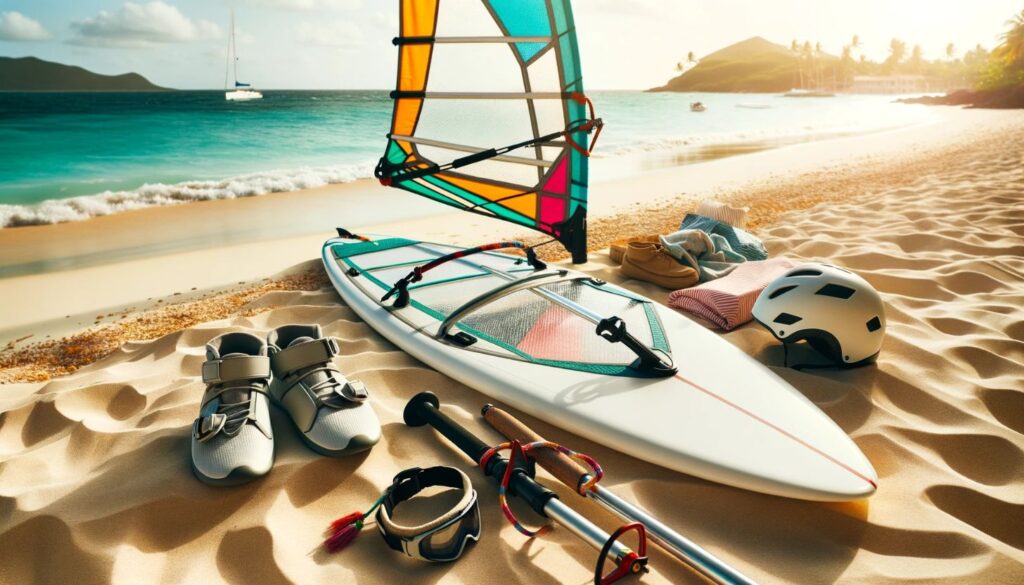
Finding Qualified Instructors
If you’re looking to take your windsurfing skills to the next level or need some guidance on the basics, attending windsurfing lessons can be immensely helpful. However, it’s essential to find a qualified instructor or school that offers lessons tailored to beginners.
When searching for windsurfing lessons, consider the instructor’s experience and teaching style, the size of the class, and the lesson duration. It’s also crucial to ensure that the instructor has the proper safety certifications and can provide appropriate safety gear during the lesson.
You can find windsurfing lessons for beginners through a simple online search or by asking for recommendations from local windsurfing enthusiasts. Many schools and instructors offer different packages, including group or private lessons, which can be tailored to your individual needs.
Joining a windsurfing school or club can provide additional benefits, such as access to equipment rentals, discounts on lessons and gear, and the opportunity to connect with other windsurfing enthusiasts.
If you’re unsure about committing to a lesson program, many schools offer trial lessons or taster sessions, which can give you a taste of what windsurfing lessons entail before committing to full lessons.

Whether you’re a complete beginner or looking to improve your existing skills, windsurfing lessons can be an excellent investment in your windsurfing journey.
Exploring Windsurfing Locations for Beginners
Choosing the right location is crucial for a successful windsurfing experience as a beginner. Look for calm, shallow bodies of water with a consistent wind to practice your skills. Research the weather conditions for the location and make sure it’s suitable for your skill level. Here are some popular windsurfing spots for beginners:
- Maui, Hawaii
- Cape Hatteras, North Carolina
- San Francisco Bay, California
- Windells Camp, Oregon
- South Padre Island, Texas
Take advantage of online resources such as Windsurfing Magazine or local windsurfing clubs to find more suitable locations for beginners. Be sure to also research the local rules and regulations, such as any restrictions on equipment or speed limits. This will help ensure your windsurfing experience is not only enjoyable but also safe.
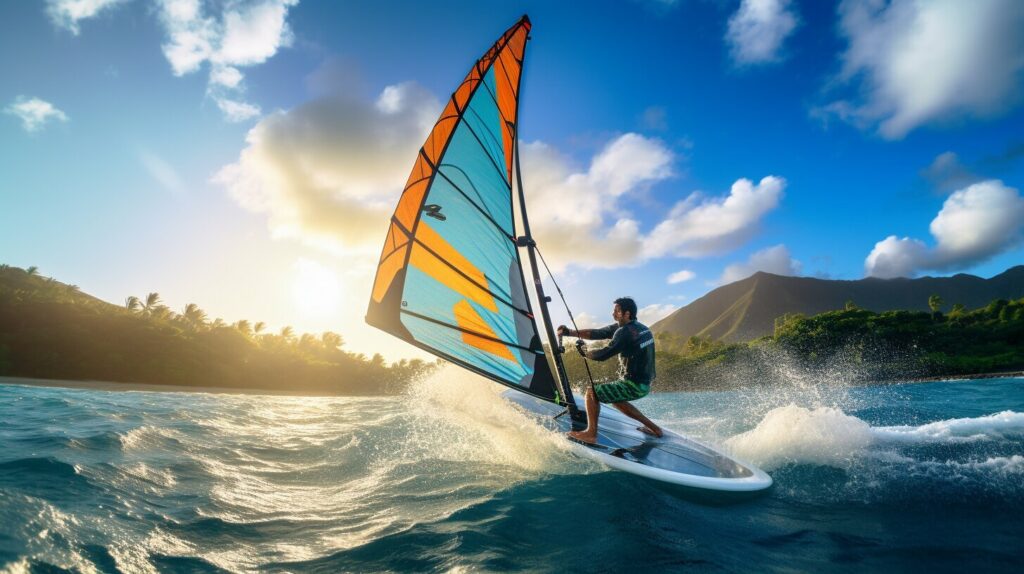
With the right gear, location, and guidance, windsurfing can be a thrilling sport anyone can enjoy. Take your time to master the basics, then progress to advanced techniques to truly experience its full potential. Don’t forget to join the windsurfing community and connect with like-minded individuals to enhance your experience. Happy windsurfing!
Maintaining and Caring for Your Windsurfing Gear
Proper maintenance and care of your windsurfing gear is important for its longevity and performance. Here are some tips on how to keep your gear in good condition:
- Rinse your board and sail with fresh water after each use to remove salt and sand.
- Dry your gear completely before storing it.
- Store your gear in a cool, dry place, away from direct sunlight.
- Check your gear regularly for any signs of wear and tear, and repair any damage as soon as possible.
It’s also important to invest in proper windsurfing gear to ensure your safety and comfort on the water. As a beginner, you may want to consider purchasing used gear or renting equipment before investing in your own. This can help you determine which type of gear is best suited for your needs and skill level.
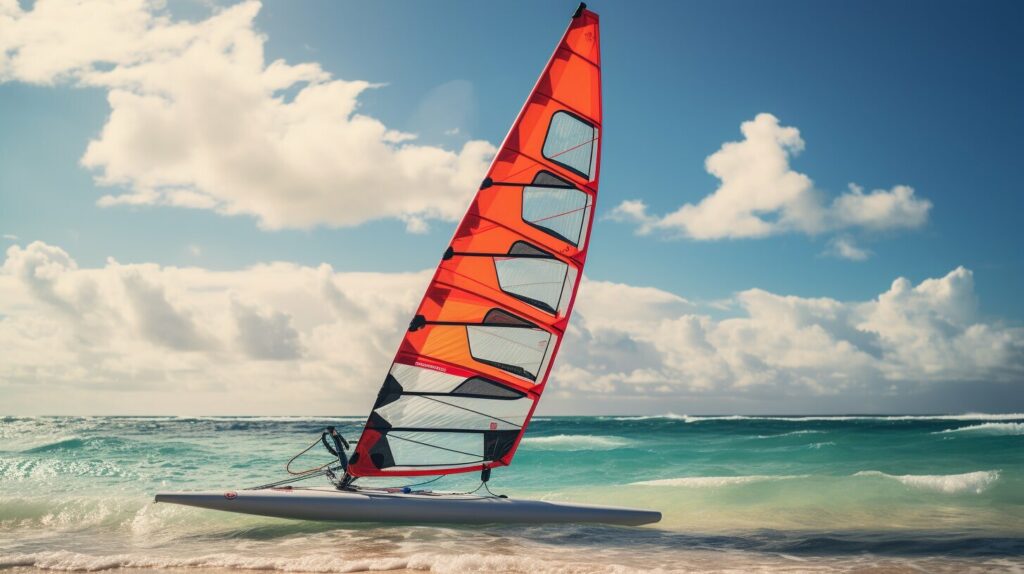
Remember that proper maintenance and care of your windsurfing gear is essential for your safety and enjoyment on the water. By following these tips, you can ensure your gear stays in good condition and lasts for many windsurfing adventures to come.
Advancing Your Windsurfing Skills
You’ve now mastered the basics of windsurfing and are ready to take your skills to the next level. While practice is key to improvement, taking windsurfing lessons for beginners can greatly enhance your experience and help you progress faster.
Look for local windsurfing schools or instructors who offer intermediate or advanced lessons. These lessons are typically geared towards developing specific techniques such as harnessing, jumping, and advanced maneuvers, as well as improving overall speed and control.
Participating in windsurfing events and competitions can also be a great way to challenge yourself and learn from more experienced windsurfers. These events often have divisions for different skill levels, allowing beginners to participate and compete alongside their peers.
Exploring different styles of windsurfing, such as wave riding or freestyling, can also add variety to your windsurfing experience and open up new opportunities for advancing your skills.
Remember, advancing your windsurfing skills takes time and dedication, so be sure to practice and always seek opportunities for improvement. Stay motivated and enjoy the journey!
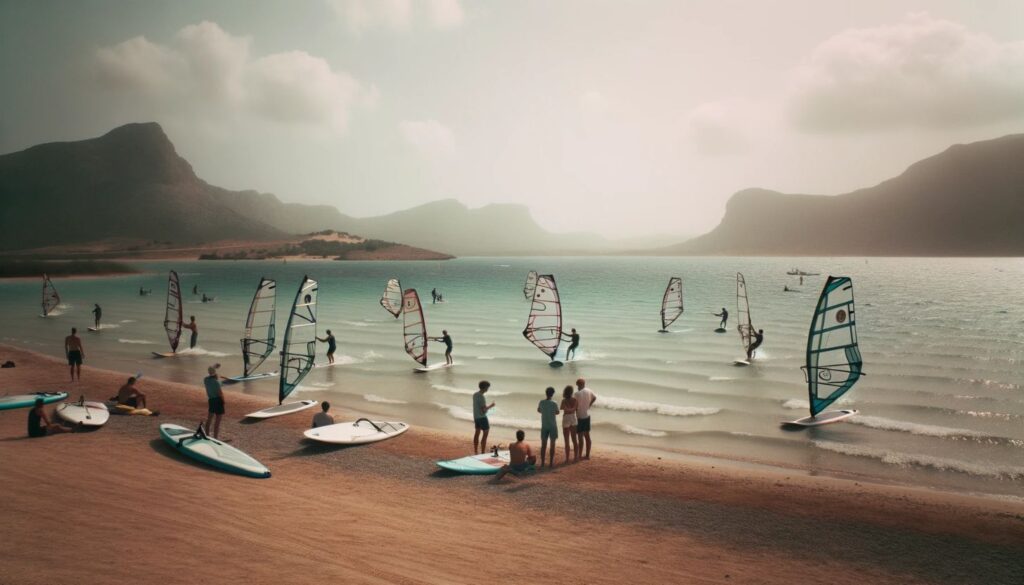
Joining the Windsurfing Community
As a beginner windsurfer, joining the windsurfing community can be a great way to connect with like-minded individuals, learn new techniques, and stay motivated. Whether you’re looking to participate in local events or simply connect with other windsurfing enthusiasts, there are plenty of resources available to help you get started.
One of the easiest ways to connect with the windsurfing community is to join a local windsurfing club. These clubs typically offer access to gear rentals, lessons, and organized events to help you improve your skills while meeting other windsurfers. You can easily find a club near you through a quick online search or by asking around at your local windsurfing beach.
If you’re unable to find a windsurfing club in your area, there are also plenty of online communities you can join. Websites like WindGuru, iWindsurf, and Boards offer forums, articles, and other resources to help you connect with other windsurfers and stay up-to-date on industry news and trends.
Whether you choose to join a physical club or an online community, the most important thing is to stay engaged and keep learning. By surrounding yourself with other passionate windsurfers, you’ll be able to progress faster and enjoy the sport even more.
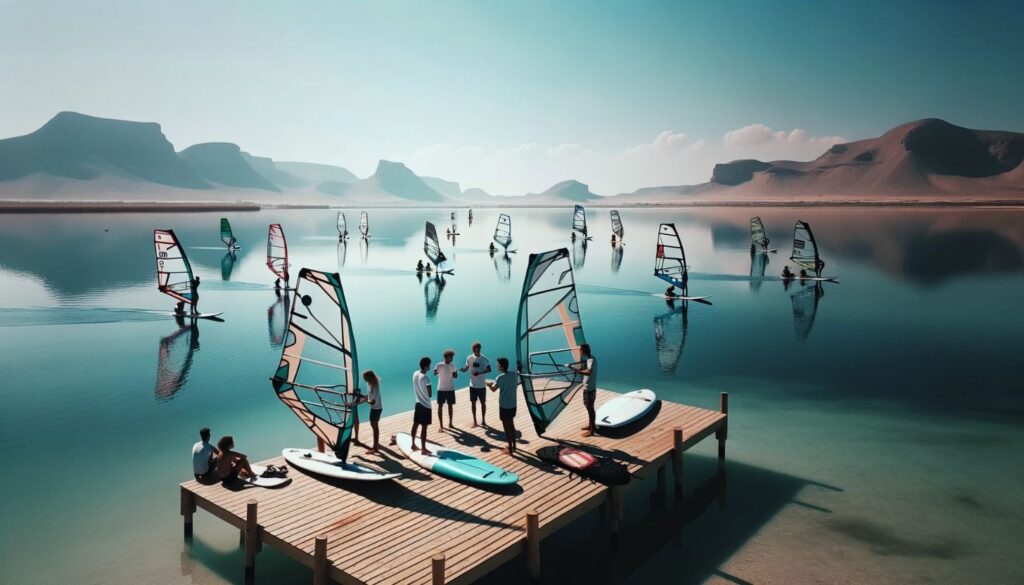
Conclusion
Whether you’re a complete novice or have some prior experience, we hope you found this guide informative and helpful in your windsurfing journey.
Remember, mastering windsurfing takes time, practice, and perseverance. Don’t get discouraged if you don’t get it perfect right away. Keep pushing yourself and don’t be afraid to try new techniques and styles.
As a beginner, it’s important to prioritize safety, follow local rules and regulations, and always be aware of changing wind and weather conditions. Be sure to properly maintain and care for your equipment to ensure its longevity and optimal performance.
Joining the windsurfing community can also greatly enhance your experience. Consider attending events, joining clubs, and connecting with fellow windsurfers to share your passion and continue learning from one another.
Thank you for reading this guide and we wish you the best of luck in your windsurfing journey!
FAQ
What is windsurfing?
Windsurfing is a water sport that combines elements of surfing and sailing. It involves standing on a board while holding a sail and using the wind to propel yourself across the water.
Is windsurfing difficult to learn?
Like any sport, windsurfing requires practice and patience. While it may take some time to master the skills, with proper instruction and practice, most beginners can learn the basics and start enjoying the sport relatively quickly.
What equipment do I need for windsurfing?
The basic equipment needed for windsurfing includes a board, a sail, a mast, a boom, a fin, and a harness. As a beginner, it’s best to start with larger and more stable boards and sails until you gain more experience.
Do I need to be physically fit to windsurf?
Windsurfing can be physically demanding, especially in stronger winds. It’s beneficial to have a basic level of fitness to help you handle the equipment and maintain control while on the water. Regular exercise and strengthening your core muscles can also improve your windsurfing performance.
Can I learn windsurfing on my own, or do I need lessons?
While it’s possible to learn windsurfing on your own, taking lessons from a qualified instructor can significantly accelerate your learning process and help you avoid common mistakes. Lessons can provide personalized guidance, safety instruction, and valuable feedback to improve your skills.
How long does it take to become proficient in windsurfing?
The time it takes to become proficient in windsurfing varies from person to person. It depends on factors such as your dedication to practice, your previous experience with water sports, and the amount of time you can spend on the water. With regular practice, most beginners can become comfortable and proficient within a few months.
Are there any age restrictions for learning windsurfing?
There are no specific age restrictions for learning windsurfing. However, it’s important to consider your physical fitness and abilities when starting any new sport. Windsurfing can be enjoyed by people of all ages, but children should always be supervised and receive appropriate instruction and safety gear.
What should I wear when windsurfing?
When windsurfing, it’s important to wear clothing that provides sun protection and allows for freedom of movement. A wetsuit or rash guard is recommended to protect your skin from water and sun exposure. Additionally, wearing a life jacket or a personal flotation device (PFD) is crucial for safety.
Are there any safety precautions I should take while windsurfing?
Yes, there are several safety precautions to keep in mind while windsurfing. Always check weather conditions and forecasts before heading out, and avoid windsurfing in extreme weather conditions or unfamiliar areas. It’s also important to stay aware of other water users and follow local regulations. Learning basic self-rescue techniques and how to react in emergency situations is essential.
Can I windsurf in any body of water?
While windsurfing can be done in various bodies of water, it’s best to choose locations that are suitable for beginners. Look for areas with calm and shallow water, minimal obstacles, and consistent winds. It’s also important to consider any local restrictions or permits required for windsurfing.
